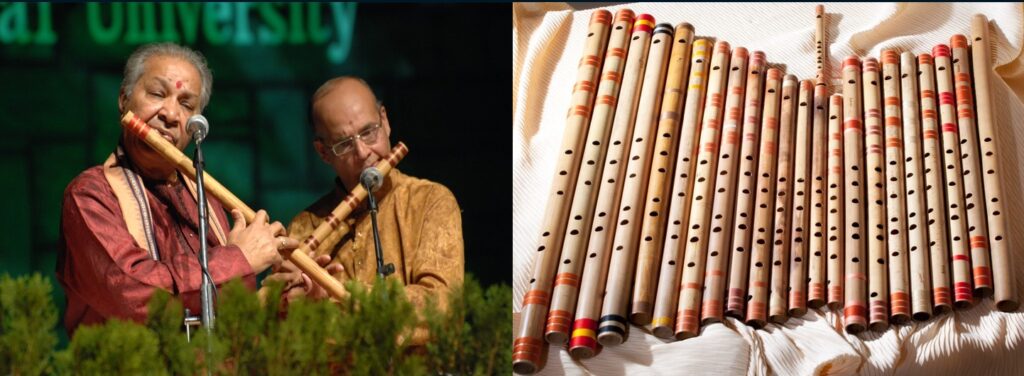
Bansuri – The Indian Bamboo Flute
The Indian Bamboo Flute is called the Bansuri. ‘Bans’ means the “Bamboo” and ‘Sur’ refers to a “Musical Note” and therefore in short Bansuri just refers to an instrument which goes on to explain to us about a musical note produced from a Bamboo when air is blown into it.
Bansuri is also known by several other names such as Bansi, Vamshi, Murali, etc. Also according to Hindu Mythology Lord Krishna is said to have been associated with this instrument and His Divine Flute attracted his Devotees and mesmerized them and the sound of His Bansuri intoxicated the Gopis (female devotees) sending them into a deep trance on hearing His celestial melodies.


A Bansuri may be either a Side Blown (Transverse) or a Straight Blown (End Blown) one. In other words straight blown flutes are played almost positioning them like the Rwcorde / Oboe and Clarinet, which are held in a vertical position. Transverse flutes or Side blown flutes are held horizontally played like the Piccolo or the Keyed Concert Flute.
In the context of Indian Music both Classical and Lighter forms, the Bansuri that we see popularly used today is a Transverse / Horizontal type flute. It has an exclusive embouchure hole at one end for blowing the air into it. It also has exclusive finger holes meant to produce the different notes by way of opening and closing the holes with the fingers simultaneously while the air is being blown into it. Generally the finger hole placement on the Bansuri is aligned in a straight line at a proportionate distance away from the blow hole deciding the Pitch of the Bansuri mainly depending on the Length and diameter suitable for the Bansuri. It involves a very scientific approach in making the instrument. The type of Banmboo needed to make the flute is of a special variety and not all Bamboos are suitable for this purpose.
In Indian Classical Music most of the time the standard Bansuri used is of a Side Blown type. On the Indian Bansuri we can reach upto two octaves easily possible ( i.e., lower Pa to Higher Pa). However with additional effort and skill one can touch the lower Ma and also could produce higher notes upto the higest Sa and beyond. This could be better understood when demonstrated practically. However with modifications and practice we can try to achieve a few more extra notes both in the lower and higher registers helping us achieve 2 and quarter to 2 and half Octaves. An important point to be noted that in India flutes used for Carnatic and Hinudtani Music are slightly different both from the point of size and the number of holes and even the style of playing. The position of the Tonic note Sa is different in understanding when both these systems are compared. Though one can shift the notes placements to play the instrument in the needed scale – in our system the common practice is to use different flute for each scale or pitch. Here is an image of complete flute set a professional need to have.

Also in the case of the Standard Bansuris the Blowing end is blocked with an artificial stopper or the natural node at a placement just before the Blow hole embouchure hole so that the sound is clearly produced by having a vent at the other end of the Bansuri for the air to pass through only in one direction after rebounding onto the stopper placed at the blowing end. This scientific principle is common to all side blown flutes. The notes (Sa Ri Ga Ma Pa Dha Ni) produced in Lower and Higher Octaves depend on the intensity of the air blown and the variation of every frequency of the note would depend on which finger holes are opened or closed in the direction of its placement.